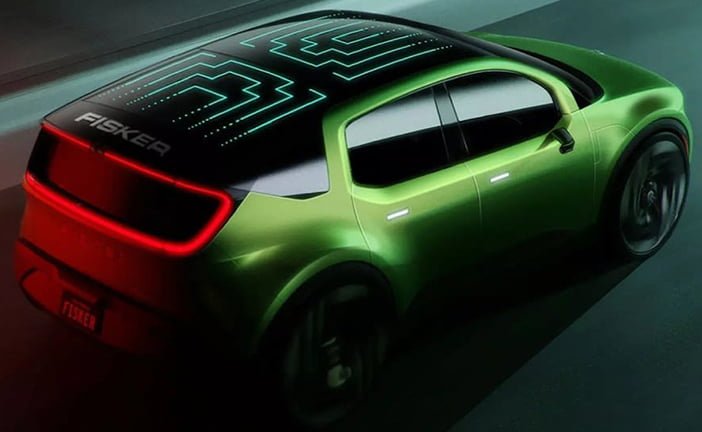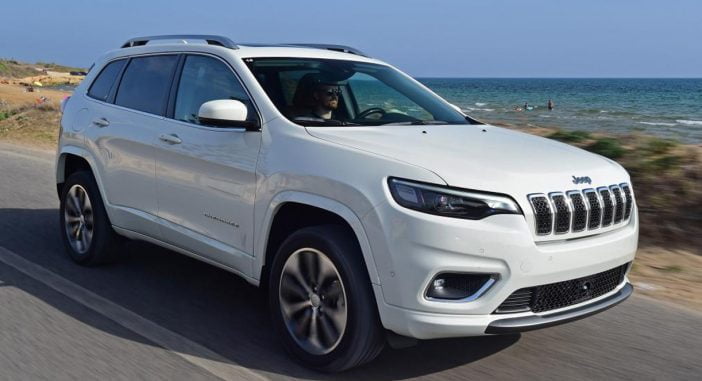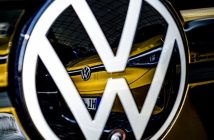+++ BMW is currently developing an architecture called New Class that will underpin a new range of EVs starting in 2025. While the platform isn’t being designed with internal combustion in mind, the German firm hasn’t ruled out making it compatible with hydrogen. “We are working on being on able to integrate hydrogen into the New Class platform. Not as of 2025 and probably only in the larger cars. We haven’t finished the project yet, but it’s a possibility”, Jürgen Guldner, the hydrogen program’s general manager, told. Starting with a blank slate gives BMW the opportunity to future-proof the New Class platform: it’s much easier and a whole lot to cheaper to design the architecture with hydrogen in mind from the get-go, even if this option is never used, than to modify it to take a hydrogen-powered drivetrain after it’s been in production for a couple of years. Guldner added that his team is looking at a clever packaging solution. “The tank system in the iX5 is pretty big and it’s located right in the middle of the car. The idea is to have smaller tanks positioned next to each other that take up the space of an EV’s battery pack. Smaller tanks, still cylindrical, but more of them, and then we’re flexible. The rest of the infrastructure is already in the car; the motor, for example. We haven’t really decided yet, but the possibility is there”, Guldner added. Regardless of whether a hydrogen-electric, New Class-based model reaches production, Guldner has high hopes for the technology. “It’s the most exciting project that I’ve worked on in my 25 years at BMW, and I’ve done some cool stuff”, he says with a smile. BMW has historically licensed its engines to a diverse list of manufacturers; the Bertone Freeclimber, the McLaren F1, the Morgan Plus Six and the Ineos Grenadier are all BMW-powered. The company told it’s open to licensing its upcoming hydrogen-electric technology. “We would if we could, but this is not the time to discuss that”, BMW boss Oliver Zipse told on the sidelines of the iX5 launch. Still at the prototype stage, the hydrogen-electric drivetrain that BMW is putting in a small handful of X5-based test mules consists of 2 storage tanks, a fuel cell, a small lithium-ion battery pack and a rear-mounted electric motor sourced from the iX. The system’s total output checks in at 401 horsepower in the iX5, it delivers about 500 km of driving range, and its tanks can be refueled in a couple of minutes. Hydrogen’s future is up in the air; some companies are investing in the technology, like BMW and partner Toyota, while others are steering clear of it. BMW believes hydrogen-electric cars can merge into the mainstream later in the 2020s and if that assessment is accurate many of its rivals may be caught off-guard. Mercedes-Benz hasn’t publicly announced plans to release a hydrogen-powered GLE, for example. “We deliver combustion engines to other manufacturers. It’s not only a few, it’s quite a lot; it’s a business model. That’s because we have superior technology that we built up over decades … and that is true for any technology. It could be for autonomous driving components, for example. So, the possibility is always there, but it must make sense. We don’t do it just for the sake of it”, Zipse explained. Similarly, Zipse didn’t fully rule out letting other brands in the BMW Group use the core company’s hydrogen technology. “We will use any opportunity, but you must always fit it to the brand. The brand fit is one of the secrets of the success of BMW. You cannot do everything just because the technology is there; there must be a solid brand fit. Currently, talking about hydrogen, that fits best to BMW. That does not mean that the other brands, whether it’s Mini, Rolls-Royce, or the M brand, will never see it. I think it’s a very good starting point”. +++
+++ S&P Global Mobility conducts all sorts of surveys and studies throughout the year to gauge CONSUMER LOYALTY and automaker brand perception. The organization recently released its 2023 Annual Automotive Loyalty Awards, with Tesla and General Motors taking top marks in the 27th iteration of the study. General Motors’ win in the “Overall Loyalty to Manufacturer” is its 19th in 27 years. S&P said that strong demand and rising inventory levels helped the automaker. Tesla took the top spot for “Overall Loyalty to Make”, with the organization citing its dominance in the EV space and an actively shopping consumer base as factors in its win. “Ethnic” buyers accounted for a massive 40 percent of new vehicle registrations last year, and were major players in Tesla’s loyalty success. S&P Global Mobility combined several groups under the “ethnic” category and said that Tesla was the overall winner with the group, seeing 52 percent of its overall loyalty volume from ethnic consumers. S&P defines ethnic consumers as buyers not from Eastern or Western Europe, including immigrants and people with heritage from those regions. S&P Mobility analyzed almost 12 million new vehicle registrations in 2022 to calculate its scores. It defines loyalty as a household that owns a new vehicle and returns to buy another vehicle of the same make, model, or manufacturer. The new purchase can replace or add to the existing garage. Outside of the winners, S&P tracks brands that improve over time. Mercedes-Benz won the complicatedly titled “Most Improved Alternative Powertrain Loyalty to Make” thanks to its new EQS. +++
+++ The J.D. Power 2023 U.S. ELECTRIC VEHICLES Experience (EVX) Ownership Study is out, and there’s change at the top. With the swelling adoption of electric vehicles in the U.S. over in the past 2 years especially, the third year of the EVX study changes focus to first-time EV buyers. Those 2 factors encouraged change at the top of both premium and mass-market segments. Among premium EVs, the Rivian R1T pickup scored overall victory in its first year of eligibility with a satisfaction score of 794 out of 1.000. The Tesla Model 3 takes second place with 759 points. Tesla had won the top two premium spots in the study in 2021 and in 2022. The average score in the premium segment was 756. The Tesla Model Y (754), Audi e-Tron (735), and Polestar 2 (724) filled out the list of the 5 eligible models this year. Among the ten eligible mass-market vehicles, the Mini Hatch Electric nabbed the overall win by scoring 782. The Kia EV6 came second with 762 points, keeping Kia in the top-2; the e-Niro won the mass-market segment the previous 2 years. The Ford Mustang Mach-E (742), Hyundai Ioniq 5 (738), and Volkswagen ID.4 (735) completed the top-5, the Niro EV (733) in sixth. All were above the segment average of 730. The four models fell below the segment average were the Ford F-150 Lightning (723), Chevrolet Bolt EUV (716), Chevrolet Bolt (711), and Nissan Leaf (698). How are the scores derived? J.D. Power worked with EV app maker and research firm PlugShare to get owner responses in 10 areas: accuracy of stated battery range; availability of public charging stations; battery range; cost of ownership; driving enjoyment; ease of charging at home; interior and exterior styling; safety and technology features; service experience; and vehicle quality and reliability. Brent Gruber, executive director of the EV practice at J.D. Power, said, “Recent vehicle launches from both new brands and traditional automakers have had a profound effect on what factors are most important in the ownership experience. Today’s EV owners are looking for quality, reliability, driving enjoyment, safety and technology features”. The Mini, in fact, scored highest of any premium and mass-market EV in the study’s highest-weighted index factor, quality and reliability. And in a surprise finding about electric pickups, owners who tow were an overall 24 points more satisfied about their ownership experience than owners who hadn’t towed. Mass-market EV owners have the same primary complaint as ICE vehicle drivers: Infotainment. Premium EV owners are most vexed by squeaks and rattles. And there’s a large satisfaction gap when it comes to public charging, premium EV owners returning a 589 satisfaction score, mass-market owners returning a score of 341. +++
+++ Henrik FISKER ’s on his third go as head of an independent carmaker. It started with Fisker Coachbuild, putting new bodies on German sports cars to create the Tramonto and Latigo. His dreams soon went electric with Fisker Automotive and the Karma. The latest dream revision birthed Fiker Inc, the company behind the Ocean. Based on details provided during the company’s Q4 and full-year 2022 results call with analysts, the third time could well and truly be the charm. The bullet points are a startup’s dream. There are 56 Ocean prototypes on the roads, 15 of them in partner Magna Steyr’s fleet for daily testing and validation. Fisker spent less money than expected in 2022 ($702 million) and has more cash on hand than expected. And if things go smoothly in 2023, the predicted spend and gross margin could leave Fisker with “potentially positive Earnings Before Interest, Taxes, Depreciation and Amortization for 2023”. Huge if it happens. If there’s slightly mixed news, it’s with the Q1 2023 timeline. The good bit is that Fisker says homologation programs in the U.S. and 7 European countries are “progressing well”, the processes expected to conclude in March. After that, the company needs to secure final regulatory approvals from the U.S. EPA, California’s Air Resources Board and the 7 international regions. Fisker touted the broad market strategy as lowering risk since getting approved in multiple markets would give the company the option to go where demand is greatest. The target has been to get the first 300 Ocean units delivered by the end of March, Fisker saying the company secured supplier commitments for the quarterly and annual build schedules. With the amount of paperwork yet to be done, though, hitting the March deadline could be close. After that, according to the CEO, it’s back to uncut good news. Those homologation programs have apparently shown ranges better than expected for the Ocean. “Instead of the Europe’s WLTP prediction of 630 kilometers, I think this will be closer to 700”, he said. As of the end of February, the company is sitting on roughly 65.000 reservations or orders for the Ocean. The goal is to manufacture 42.000 units this year, the ramp-up going from 300 in Q1 to 8.000 in Q2, more than 15,000 in Q3 and at least 19.000 in Q4. We’ll begin to know what the Ocean is really about when Edition One buyers begin receiving their units. With the Ocean on a roll, Fisker updated the call audience on the Personal Electric Automotive Revolution (P.E.A.R.) hatchback (pictured below), showing a couple of renderings of the series production design. The company has more than 5.600 reservations for the Pear, still planned to start at $29,900. Aero testing has reportedly supported claims the long-range version will go “well over 300 miles”. On top of that, next-gen functionality and features will be thanks in part to “a truly revolutionary electrical architecture with the many ECUs in the traditional vehicle consolidated down to just a few central computer units, which we call the Blade computer”. And with plans to release vehicles in other segments, the boss touched on the planned Alaska electric pickup. Said to be a lifestyle truck loosely based on the Ocean, it will “have some amazing features that have never been done on a pickup truck before”. The Ronin convertible is also due for a conceptual debut this year. Fisker shares shot up by a third Monday as a profitability call by the electric vehicle maker and an agreement for charging stations appeared to take precedence over a quarterly loss that missed expectations. The stock jumped as much as 36% to $7.75, a more than 2-week high, then pared the advance to close by a still-hefty 30% at $7.41. The surge came after the release of the company’s fourth-quarter financial results. In it, Fisker reiterated its 2023 production target of up to 42.400 units, offering a contrast to last week’s weak production goal from EV rival Lucid as it deals with supply-chain problems. Fisker also said it had about 65.000 reservations for its Ocean, up from 62.000 at the end of October. In addition, management forecast “potentially positive” earnings before interest, taxes, depreciation, and amortization for 2023. “Our reservations keep rising. We’re going to have a profit this year, which is very unusual for a startup EV company”, CEO Henrik Fisker said. The company also said Monday it has a deal with ChargePoint under which Fisker EV owners will have access to more than 210.000 active ports and more than 400.000 roaming ports in North America. Referring to rival Tesla, Fisker told the company run by Elon Musk has 7.000 chargers in the US. For its part, Tesla says it has more than 40.000 Superchargers worldwide. “ChargePoint and their affiliates has 400.000…so I think it’s definitely game-changer. It’s going to be super-easy for you to charge your Fisker Ocean”, Fisker said. +++

+++ STELLANTIS is moving closer to closing its factory in Belvidere as it prepares for the costly transition from internal combustion to electric vehicles. The factory, which now employs about 1.350 workers, officially was placed on “idle” by the company on Tuesday. That term means it intends to shut down the plant. Belvidere’s future is likely to be a lightning-rod issue in national contract talks coming up this summer with the United Auto Workers union, one that could bring a painful strike. In a statement Tuesday, the UAW said that the decision to idle the plant will not go uncontested. “This economic dislocation is a choice made by Stellantis to reap even higher profit”, union vice president Rich Boyer said in a statement. “We will highlight their corporate greed to workers, community, taxpayers, and consumers”. In a meeting with reporters Tuesday, Carlos Tavares, CEO of the company formed by combining Fiat Chrysler and France’s PSA Peugeot, said Stellantis is “looking for solutions” for Belvidere, which now has no new vehicle to build. The last Jeep Cherokee rolled off the plant’s assembly line on Tuesday. The company, Tavares said, is executing a transformation to electric vehicles, which are 40% more expensive to make than those with internal combustion engines. Stellantis, he said, can’t pass the increased costs to consumers because many wouldn’t be able to afford new cars. It also can’t sell EVs at a loss, so it’s left with absorbing the added costs. “We need to adapt to this new world”, Tavares said. “The reality of the transformation of the market is the reality that we need to face”. He said the company is not seeking specific concessions from the Belvidere plant. “This is a global issue. This is not a Belvidere issue”, he said. Stellantis, Tavares said, has to optimize its manufacturing and distribution footprints. “If we don’ fix it then everybody’s going to be in trouble”. he said. But UAW President Ray Curry said the company’s “ill-advised decision” will disrupt lives, uproot families and cause repercussions through the regional parts supply chain network. Shawn Fain, his opponent in a UAW officers’ election that is coming to an end soon, said the union should have enforced clauses in its contract that prevent plants from being closed. The union said it has negotiated and Tavares said the company has agreed to, retirement packages as well as voluntary termination and pre-retirement leaves for workers. It’s also working on relocation for interested workers, the UAW statement said. The union says about 2,300 employees are affected. The Belvidere plant could wind up making Stellantis the lead company in contract talks that open this summer with the Detroit Three automakers. As a potential warning to the automakers, the union last week raised strike pay from $400 to $500 per week. In the past 2 years, the UAW has become more aggressive against employers as workers have become more scarce. It has gone on strike against CNH Industrial, Deere & Co., the University of California system and Volvo Trucks to win larger pay raises and other benefits. +++

+++ Mexico’s President Andrés Manuel López Obrador said Tuesday that electric car company TESLA has committed to building a plant in the industrial hub of Monterrey in northern Mexico. López Obrador said the promise came in phone calls he had Friday and Monday with Tesla head Elon Musk. López Obrador had previously ruled out placing such a plant in the arid northern state of Nuevo Leon, where Monterrey is the capital, because he didn’t want any water-hungry factories in a region that has suffered severe water shortages. But he said Musk’s company had offered several commitment to address those concerns, including using recycled water. “There is one commitment that all the water used in the manufacture of electric automobiles will be recycled water”, López Obrador said. López Obrador did not specify the size of the investment or what the plant would produce, noting that the company planned to release more details on Wednesday. But he said “this is going to mean a considerable investment and many, many jobs. My understanding is that it will be very big”, López Obrador said, but it was unclear if the plant would produce batteries, noting that “the batteries are still pending”. Tesla already has 2 plants outside the United States, one in Shanghai and another near Berlin. Monterrey is highly industrialized and close to the U.S. border, and had long been considered the frontrunner for any Tesla investment. But the city suffered such severe water shortages in 2022 that many homes went weeks with intermittent or no water supply in 2022. The government is building a 100 kilometer pipeline to bring more water in from a dam to increase the supply. López Obrador had previously said his government “simply won’t grant permits” for any new plants there. But apparently Musk’s proposal overrode the president’s stance. The announcement was a disappointment for more water-rich southern states which had begun jockeying for the Tesla plant after López Obrador’s comments last week. The governor of Nuevo Leon state, where billboards went up last year saying “Welcome Tesla”, crowed about Tuesday’s announcement. “Mexico won, Nuevo Leon won, We all win!”, Gov. Samuel García wrote in his Twitter account. Musk at times has floated the idea of building a $25.000 electric vehicle that would cost about $20.000 less than the current Model 3, now Tesla’s least-expensive car. Many automakers build lower-cost models in Mexico to save on labor costs and protect profit margins. López Obrador said Mexico wouldn’t match any U.S. subsidies to win the Tesla plant, referring to U.S. incentives under the 2022 Inflation Reduction Act, which provides a tax credit of up to $7.500 for electric vehicles assembled in North America. “A subsidy like that, we cannot give subsidies like that”, the president said, adding “Mr. Musk was very attentive, respectful” of Mexico’s position. +++
+++ When Akio Toyoda stepped down as chief executive officer of TOYOTA in January, it seemed like an unofficial capitulation to the pounding his company’s been taking in the media. Analysts and press have pummeled Toyota for being slow to embrace electric vehicles and incoming leader Koji Sato is making EVs a priority. However, that doesn’t necessarily mean using Toyota’s manufacturing might to fast-track EVs into production. In the short term, it may be just the opposite. Toyota is taking an almost blank-slate approach to its EV strategy. The trade publication claims to have spoken anonymously with several high-ranking insiders, drawing the conclusion that Toyota may be dissatisfied with its e-TNGA platform that underpins its first EVs, the BZ4X and Lexus RZ, as well as the Chinese-market BZ3. Recently, engineers at Toyota disassembled a Tesla Model Y to study its competition, a common practice among automakers. In California, which has over 5 times more EV registrations than the next most EV-eager state according to the Department of Energy, the Model Y outsold Toyota’s wildly popular RAV4, and the Model 3 outsold the Camry last year. What the engineers found were innovative manufacturing techniques that led one unnamed insider to call the Model Y “a work of art”. The Model Y’s “giga-press” manufacturing technique reduces the main body of the car to 2 large sections, and the battery pack acts as part of the vehicle’s structure. Toyota’s e-TNGA platform on the other hand, requires many more stamped pieces. One Toyota source told that Tesla’s approach resulted in a vehicle that was 100 kilos lighter with hundreds of fewer parts. Additionally, Toyota’s battery packs are installed separately and thus limited in size. All that translates to, in consumer-facing parlance, less range and the lack of features such as a frunk. Some of these restrictions come from the fact that the e-TNGA platform was originally developed for gasoline and hybrid cars in 2015. In fact, Toyota is still in the process of converting some of its factories around the world to accommodate it. But Sato and his team have halted development of some upcoming e-TNGA vehicles in order to work on a clean-sheet platform specifically tailored to EVs. Toyota said that the plan was underway before Akio Toyoda announced his retirement. The move seemed timed for optics, but Toyoda led the company for 14 years, longer than several other influential presidents. Additionally, Toyota plans to continue with its multi-pronged approach, offering hybrids, PHEVs, and hydrogen cars to suit various markets around the world. Toyota gleaned considerable EV experience thanks to its joint venture with China’s BYD, with which it developed the bZ3. Toyota also has a dedicated zero-emissions vehicle R&D center and has announced plans to update its Kentucky factory in order to build EVs there by 2025. However, Toyota is not entirely sure that EVs made by Tesla or BYD would stand up to the company’s rigorous internal quality standards. “If BYD tests their batteries to a life span of 100.000 kilometers, we test ours to 200.000”, one insider told. That kind of extra scrutiny takes time and money, but have helped cement Toyota’s legendary reputation of durability and build quality. Sources also indicated that Toyota wants to make sure it can secure enough battery materials to avoid bottlenecks in manufacturing before going all-out on EVs. One such executive told: “We have to plan for the next 20 years, not just the next 5”. +++
+++ Reports out of Japan say that the current, fifth-generation TOYOTA SUPRA will not be the last. However, it might be the last one with an internal combustion engine. The grapevine whispers claim that a next-gen GR Supra will carry the nameplate on as an electric sports car. But before that happens, an even more hard core performance variant may be built to send off the gasoline engine with a bang. The ultimate ICE Supra may have as much as 550 horsepower, which would be a significant step up from the current 382 for the 3.0-liter turbo six. That comports with the output of the same engine in the BMW M3 CS and M4 CSL. Instead of the GR Supra name, it could wear the GRMN prefix, which stands for “Gazoo Racing, tuned by the Meister of the Nürburgring” and is reserved for only the hottest of the hot GR models. The name is a tribute to long-time Toyota chief test driver Hiromu Naruse, who died by the circuit while testing a Lexus LFA. This supra Supra, if you will, is slated to be the final model on the A90 chassis, production of which comes to an end in 2025. After that, the 6th gen Supra would go electric. That was hinted at by chief engineer Tetsuya Tada as early as 2019. The magazine says the so-called A100 would be rear-wheel-drive and have an equivalent electric output of about 450 to 500 horsepower. The e-Supra would also adopt the pseudo-manual transmission that Toyota has been developing for EVs, which mimics the feel of a traditional standard gearbox. Perhaps most surprisingly, they say the 2-seater will take the form of a mid-engined sports car, as an EV platform will allow for freedom of design. If true it will be good news for enthusiasts. A swan song ICE blast is always interesting, and the industry needs a good affordable EV sports car option. Hopefully this roadmap comes to fruition. +++



